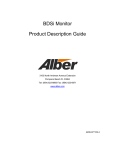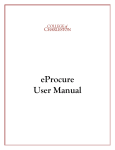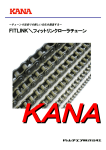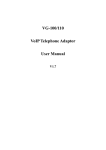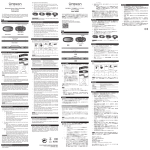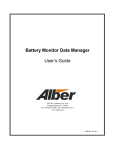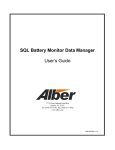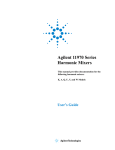Download Emerson Alber BDS-40 Brochures and Data Sheets
Transcript
BDS–40 Monitor Product Description Guide Trust Your Batteries 3103 North Andrews Avenue Extension Pompano Beach FL 33064 Tel: (954) 623–6660 Fax: (954) 623–6671 www.alber.com 4200–063 R4.3 Copyright and Disclaimer BDS‐40 Monitor Product Description Guide Document Revision 4.3 Part Number Revision History 4200‐063 Revision Date of Change Description of Change By 4.2 01/07/09 Original document LL, ED 4.3 06/08/2012 Added new cabinet options and configurations. MS BDS–40 Product Description Guide P/N 4200–063 Revision 4.3 2012 Albércorp, 3103 North Andrews Avenue Extension, Pompano Beach FL 33064 This guide may not be copied in whole or in part without express written permission from Albércorp. Information in this document is subject to change without notice. Microsoft, Microsoft Windows, Microsoft Explorer, and Microsoft Access are registered trademarks of Microsoft Corporation. Pentium is a registered trademark of Intel Corp. WinZip is a registered trademark of NICO Mak Computing, Inc. UL is a registered trademark of Underwriters Laboratories, Inc. Adobe Acrobat is a registered trademark of Adobe Systems, Inc. Printed in the United States of America Table of Contents Table of Contents 1. Product Description .................................................................................................. 1 1.1 Normal Operating Mode .............................................................................................. 1 1.2 Discharge Mode .......................................................................................................... 1 1.3 Resistance Test Mode................................................................................................. 1 1.4 Alarm Features ............................................................................................................ 2 1.5 Features ...................................................................................................................... 2 1.6 Battery Monitor Data Manager BMDM Program Features ................................................. 2 1.7 Optional Accessories ...................................................................................................... 2 2. Panel Controls and Indicators ................................................................................. 3 2.1 BDS–40 System .......................................................................................................... 3 2.2 Status TX, RX and Service-Upper............................................................................... 4 DCM TX and RX, COM Port, Critical Alarm, Maintenance Alarm, and Resistance Test-Lower .................................................................................................................... 4 Local Port/USB Connector ........................................................................................... 5 Alarm Reset Switch ...................................................................................................... 5 Base Unit Controller Connectors‐Rear Panel ................................................................ 6 Input, Output, TELCO, Critical Alarm, Maintenance Alarm, Remote Reset, Fiber Optics, LAN, and Local ................................................................................................ 6 Base Unit DCM Connectors-Rear Panel....................................................................... 7 Input, Temperature, Transducers, Fiber Optics and J1 through J5 ............................... 7 Base Unit DCM Controls – Rear Panel .......................................................................... 7 Plus Unit Indicators-Front Panel................................................................................... 8 Plus Unit DCM Controls – Rear Panel ......................................................................... 10 3. Configurations ......................................................................................................... 10 3.1 BDS-40 Monitor Cabinet Configurations ................................................................... 11 BDS-40 Monitor Cabinet Configurations (Continued)............................................... 12 BDS-40 Monitor Cabinet Configurations (Continued)............................................... 13 3.2 BDS-40 Monitor Open Rack Configurations.............................................................. 15 BDS-40 Monitor Open Rack Configurations (Continued) ......................................... 16 4. Specifications .......................................................................................................... 17 4.1 BDS–40 Base Unit .................................................................................................... 17 Power .......................................................................................................................... 17 Fuses ........................................................................................................................... 17 4200–063 R4.3 i Inputs .......................................................................................................................... 17 Outputs ....................................................................................................................... 17 Parameters / Features ................................................................................................ 18 Measurement Range / Tolerance ............................................................................... 18 Communication ........................................................................................................... 18 Data Storage ............................................................................................................... 18 Control Switches ......................................................................................................... 18 Operating Environment .............................................................................................. 18 Dimensions.................................................................................................................. 18 Agencies ...................................................................................................................... 19 4.2 Plus Unit .................................................................................................................... 19 Power .......................................................................................................................... 19 Fuses ........................................................................................................................... 19 Inputs .......................................................................................................................... 19 Outputs ....................................................................................................................... 19 Parameters / Features ................................................................................................ 19 Measurement Range / Tolerance ............................................................................... 19 Communications ......................................................................................................... 20 Data Storage ............................................................................................................... 20 Control Switches ......................................................................................................... 20 Dimensions.................................................................................................................. 20 Agencies ...................................................................................................................... 20 Drawings Important Note: The drawings in this manual may not be the most recent revision and are included for reference only. Refer to the Engineering Drawing Package included with your system for the newest drawings. General Assembly, Base Unit BDS–377–D1695 General Assembly, Plus Unit BDS–378–D1695 4200–063 R4.3 ii List of Figures Figure 1. BDS-40 Base Unit Front View ....................................................................................... 4 Figure 2. BDS-40 Base Unit Front Panel Indicators in Color ........................................................ 4 Figure 3. BDS-40 Local Port on Front Panel-USB ........................................................................ 5 Figure 4. Alarm Reset Switch ....................................................................................................... 5 Figure 5. Base Unit Rear Panels .................................................................................................. 6 Figure 6. BDS-40 Base Unit Controller Rear Panel Connectors ................................................... 6 Figure 7. Base Unit DCM Rear Panel Connectors ........................................................................ 7 Figure 8. BDS–40 Base Unit DCM Controls ................................................................................. 7 Figure 9. BDS-40 Plus Front Panel ............................................................................................... 8 Figure 10. BDS-40 Plus Front Panel Status Indicators ................................................................. 8 Figure 11. BDS-40 Plus Unit Rear Panel ...................................................................................... 9 Figure 12. BDS-40 Plus Unit Controller Rear Panel Connectors .................................................. 9 Figure 13. BDS–40 Base Unit DCM Controls ............................................................................. 10 4200‐063 R4.3 iii 6/14/2012 1. Product Description The BDS‐40 is a stand‐alone monitor for UPS applications and is designed for use with UPS battery cabinets. Albér monitors provide early warning detection of battery problems. The monitor checks the state of health of each cell by performing a proactive resistance test, a reliable predictor of battery performance. In addition, to indicate immediate battery health and monitor status of a given location, the system reports to a Central computer a generic PC displaying status screens. Using polling and data transfer algorithms, the Battery Monitor Data Manager BMDM software program with a PC help to manage over 1000 monitor systems. Data is stored in the computer database for later analysis and reporting. At any time, service personnel may call a battery location from the Central computer or a remote location, or directly connect to the monitor without losing contact with the computer. The Data Manager string and monitor status indicators make central battery monitoring easy. Terms such as Discharging, Alarm or Warning for string status or Active for monitor status quickly summarize events. Conditions reported to the Central computer are displayed as a list, to easily identify trouble spots. The system also features several methods of automated reporting of alarm occurrences, such as contacting key personnel via a pager, email or fax. Flexibility was a major design consideration. Because the monitors are stand‐alone units with no external computer needed, a primary protocol using Modbus ASCII was selected for easy incorporation of the monitor into large‐scale facility monitors. This allows third‐party interfaces to access all the stand‐ alone features of the monitor, yet leaves the advanced features of the BMDM remote communication software available for service personnel. 1.1 Normal Operating Mode In normal mode, the system scans all parameters in one to five seconds, depending on the configuration. As readings are taken, they are compared to user‐programmed alarm levels. The monitor can then call a Central computer and energize an alarm contact if a parameter exceeds a level. Front panel LEDs indicate scan and alarm status, and alarm events are stored in memory for future analysis. The BDS can be programmed for critical and maintenance alarms. 1.2 Discharge Mode If a discharge is detected, the system goes into a data logging mode and stores battery voltages and discharge current into a discharge record. 1.3 Resistance Test Mode A battery resistance test may be performed at user‐set intervals. The test is similar to that performed by the Albér Cellcorder. On a BDS‐40, up to ten intertiers can be configured for this measurement. 4200–063 R4.3 1 1.4 Alarm Features The monitor may be set to automatically call the Central computer to report an alarm condition when detected. You can program high and low alarm levels on all voltage and temperature parameters, and a high alarm level for resistance. When a parameter goes outside the normal range, the monitor stores the event in memory, the Alarm LED lights, and an alarm relay with a Form C contact energizes. The alarms may be set for latching or nonlatching. 1.5 Features This section describes standard and optional BDS‐40 features. Scans all pertinent battery parameters, such as overall voltage, cell voltages, current, and temperature. Performs a scheduled resistance test of all cells/jars and intertiers, and stores results for trending analysis. Auto detects discharges based on Overall Volts or Discharge Current, and stores data for real time or accelerated time playback. Signals if any parameter is outside user‐programmed limits, energizes a Form C relay contact, and calls a Central computer to report the alarm condition. Communicates with an external computer via USB, RS‐232, modem, and LAN. Network compatible. 1.6 Battery Monitor Data Manager BMDM Program Features 1.7 Windows 2000, XP, 7 and 8 compatible Central computer control software. Easy to read string and monitor status. Automatic polling for over 1000 monitor sites for monitor and string status reporting. Historical event list for complete string history. Automatically receives calls from monitors and updates the central database for data analysis. Service mode for service personnel, and local RS‐323 and USB direct connect viewing of string details and system setup when loaded on a laptop computer. Microsoft Access database compatible, with management of all stored data. Playback of discharge rundown test and controlled rundown test data. Automatic paging, emailing, and faxing of alarm events. Instant Trend graphs of any selected parameter Complete memo tracking down to the cell/module level. Status display can be customized for multi–customer monitoring. Network compatible. SQL server compatible Optional Accessories Hall effect Current Transducer (CT) for measuring discharge and float current. Temperature sensor: Electrolyte Probe or Contact Ambient Probe. Network interface. Modem 4200–063 R4.3 2 Panel Controls and Indicators 2. Panel Controls and Indicators This section describes the front and rear panels of the discreet components that comprise a typical BDS– 40 system. Additional descriptions may appear elsewhere in this manual or in related manuals. Note: Drawings in this manual may be for reference only or superseded by later drawings. For the latest information, refer to the drawings supplied with your system. Panel indicator colors are: Red (R) Yellow (Y) Green (G) 2.1 BDS–40 System The BDS–40 system consists of a BDS‐40 Data Collection Module: BDS–40 Controller Module BDS–40 Data Collection Module 4200‐063 R4.3 3 2.2 Status TX, RX and Service-Upper Figure 1. BDS‐40 Base Unit Front View Figure 2. BDS‐40 Base Unit Front Panel Indicators in Color Status (G) Upper TX Green (G) RX Green (G) Service Red (R) Flashes during normal operating conditions Flashes during fiber optic transmit Flashes during fiber optic receive Unit Requires factory service, usually because internal temperature exceeded specifications. DCM TX and RX, COM Port, Critical Alarm, Maintenance Alarm, and Resistance Test‐ Lower DCM TX Green (G) DCM RX Green (G) Status Green (G) Lower COM Port Green (G) Critical Alarm Red (R) Maintenance Alarm Yellow (Y) Resistance Test Green (G) 4200–063 R4.3 Flashes during fiber optic transmit. Flashes during fiber optic receive. Flashes during normal operating conditions. Flashes to indicate communication via LAN port or an incoming call. Critical alarm detected Maintenance alarm detected Performing a manual or automatic resistance test 4 Panel Controls and Indicators Local Port/USB Connector Figure 3. BDS‐40 Local Port on Front Panel‐USB LOCAL PORT USB port. Connects to a laptop computer. . Alarm Reset Switch During normal operation, clears latched alarms. If held during power up, clears existing names in the BDS, disables alarms, disables dial out, and resets the password to “alber”. Figure 4. Alarm Reset Switch 4200‐063 R4.3 5 Base Unit Controller Connectors‐Rear Panel Figure 5. Base Unit Rear Panels Input, Output, TELCO, Critical Alarm, Maintenance Alarm, Remote Reset, Fiber Optics, LAN, and Local Figure 6. BDS‐40 Base Unit Controller Rear Panel Connectors 1. Input 115VAC 50/60Hz or 230VAC 50/60Hz (optional) AC Power block 2. Output Power 1 to 6 3. TELCO 4. Critical Alarm 5. Maintenance Alarm 6. Remote Reset 7. Fiber Optics Rx and Tx 8. LAN 9. Local 4200–063 R4.3 User replaceable fuse and receptacle for AC power cord Power switch for system on/off. Up to six connectors providing DCM power 24VAC at 1A. (Configuration dependent) RJ‐11 jack. Option dependent Communicates with a remote computer via telephone. Form C alarm contacts, software configurable. Form C alarm contacts, software configurable. Reads momentary contact closure. Requires a user‐supplied 12V signal. Fiber optic receive / transmit ports for system communication. Optional RJ‐45 port. Communicates with a remote computer via network. DB‐9 RS‐232 port. 6 Panel Controls and Indicators Base Unit DCM Connectors‐Rear Panel Input, Temperature, Transducers, Fiber Optics and J1 through J5 Figure 7. Base Unit DCM Rear Panel Connectors 1. Input 24VAC 50/60Hz AC Power For 24VAC power. 2. Temperature 1 and 2 For Temperature Sensors 3. Transducers‐Float Current and Discharge Current For Float Current and Discharge Current Transducers Fiber optic transmit / receive ports for String communication. Connects voltage sense and resistance test leads to the batteries. 4. Fiber Optics TX and RX 5. J1 through J5 Base Unit DCM Controls – Rear Panel Settings – DCM Number and String Number Figure 8. BDS–40 Base Unit DCM Controls DIP switches Set string identification DCM number Settings ‐ DCM Number and String Number 4200‐063 R4.3 7 Plus Unit Indicators‐Front Panel Figure 9. BDS‐40 Plus Front Panel The BDS‐40 Plus Unit is a Data Collection Module. Status, TX, RX, and Service Figure 10. BDS‐40 Plus Front Panel Status Indicators Status Green (G) Upper Flashes during normal DCM operating conditions TX Green (G) Flashes during fiber optic transmit TX Green (G) Flashes during fiber optic receive Unit requires factory service, usually because internal temperature exceeded specifications or over current during resistance test. Service Red (R) 4200–063 R4.3 8 Panel Controls and Indicators Plus Unit Connectors‐Rear Panel Figure 11. BDS‐40 Plus Unit Rear Panel Input, Temperature, Transducers, Fiber Optics, J1 though J5 Figure 12. BDS‐40 Plus Unit Controller Rear Panel Connectors 1. Input 24VAC 50/60Hz AC Power For 24VAC power. 2. Temperature 1 and 2 For Temperature Sensors 3. Transducers ‐ Float Current and Current For Float Current and Discharge Current Transducers 4. Fiber Optics TX and RX Fiber optic transmit / receive ports for String 1 communication. Connects voltage sense and resistance test leads to the batteries. 5. J1 through J5 4200‐063 R4.3 9 Plus Unit DCM Controls – Rear Panel Settings – DCM Number and String Number Figure 13. BDS–40 Base Unit DCM Controls DIP switches. Set string identification and DCM number. Settings ‐ DCM Number and String Number 3. Configurations This section is an overview of the BDS‐40 monitor configurations. The BDS‐40 model numbers are structured as follows. Thus, a typical model number might be 1003‐750A CRAA21. 1003‐nnn XXxxxxxx required for 16V jars (1002‐nnn may be substituted with 1003‐nnn if monitoring 12V jars) The BDS‐40 model is 1003, followed by: 750 to indicate a Base Unit 751 to indicate a Plus Unit The following group of letters and numbers indicate cabinet options and open rack configurations: 4200–063 R4.3 10 Configurations 3.1 BDS-40 Monitor Cabinet Configurations Position XXxxxxxx Cabinet Configurations Cabinet Options 4200‐063 R4.3 A_xxxxxx 1X40X12, 10S of 4J B_xxxxxx 1X40X12, 4S of 10J C_xxxxxx 1X36X12, 4S of 9J D_xxxxxx 1X36X12, 3S of 12J E_xxxxxx 1X30X12, 5S of 6J F_xxxxxx 1X30X12, 10S of 3J G_xxxxxx 1X40X12, 4S,12,12,8, of 8J H_xxxxxx 1X40X12, 8S of 5J I_xxxxxx 1X40X12, 5S of 8J J_xxxxxx 1X30X12, 3J, 6S of 4J, 3J K_xxxxxx 1X30X12, 6J, 3S of 8J L_xxxxxx 1X20X12, 4S of 5J M_xxxxxx 1X32X12, 4S of 8J N_xxxxxx 4S of 8J or 3S 8J and 2S 4J O_xxxxxx 1X29X12, 1S of 5J and 3S of 8J P_xxxxxx 1X30X12, 4S of 8,8,8 of 6J 11 BDS‐40 Monitor Cabinet Configurations (Continued) Position XXxxxxxx Cabinet Configurations Cabinet Options 4200–063 R4.3 Q_xxxxxx 1X20X12, 4S of 6,6,6 of 2J R_xxxxxx 1X30X12, 2S of 15J S_xxxxxx 1X30X12, 3S of 10J T_xxxxxx 1X40X12, 4S of 6,12,12, of 10J U_xxxxxx 1X30X12, 6S of 5J V_xxxxxx 1X20X12 4S of 2,6,6, of 6J W_xxxxxx 1X24X12, 8S of 3J X_xxxxxx 1X40X12, 2S of 20J Y_xxxxxx 1X40X12, 2S of 15 and 1S of 10J Z_xxxxxx 1X30X12, 6S of 4J and 2S of 3J 01xxxxxx 1X24X12, 6S of 4J 02xxxxxx 1X33X12, 1S of 33J 03xxxxxx 1X33X12, 1S of 15J and 1S of 18J 04xxxxxx 1X40X12, 1S of 6J, 4S of 7J and 1S of 6J 05xxxxxx 1X32X12, 1S of 32J 06xxxxxx 1X26X12, 1S of 8J and 2S of 9J 07xxxxxx 1X18X12, 2S of 9J 12 Configurations BDS‐40 Monitor Cabinet Configurations (Continued) Position XXxxxxxx Cabinet Configurations Cabinet Options 4200‐063 R4.3 08xxxxxx 1X40X12, 2S of 12, 1S of 9J and 1S of 7J 09xxxxxx 1X32X12, 2S of 9J, 1S of 5J and 1S of 9J 10xxxxxx 1X40X12, 3S of 13, 13, of 14J 11xxxxxx 1X20X12, 3S of 7,6, of 7J 12xxxxxx 1X36X12, 9S of 4J 13xxxxxx 1X33X12V, 1S of 4J, 4S of 6J, 1S of 5J 14xxxxxx 1X40X12V, 4S of 4J, 4S of 6J 15xxxxxx 1X36X12V, 4S of 8J, 1S of 4J 16xxxxxx 1X36X12V, 1S of 5J, 2S of 3J, 5S of 5J 17xxxxxx 1X30X16V, 10S of 3J 18xxxxxx 1X30X16V, 5S of 6J 19xxxxxx 1X34X12V, 1S of 10J, 2S of 12J 20xxxxxx 1X20X12V, 5S of 4J 21xxxxxx 1X36X12V, 2S of 18J 22xxxxxx 1X34X12V, 3S of 9J, 1S of 7J 23xxxxxx 1X30X12V, 1S of 14J, 1S of 16J 24xxxxxx 1X36X12V, 4S of 10,8,10,8J 13 Position XXxxxxxx Cabinet Configurations Cabinet Options 25xxxxxx 1X32X12V, 3S of 2J, 8S of 3J, 1S of 2J 26xxxxxx 1X30X12V, 8S of 4J 27xxxxxx 1X24X12V, 4S of 6J 28xxxxxx 1X30X16V, 6S of 5J 29xxxxxx 1X40X12V, 6S of 2S8J, 2S4J, 2S8J 30xxxxxx 1X18X12V, 3S of 6J 31xxxxxx 1X24X12V, 3S of 8J 32xxxxxx 1X30X12V 2S of 12J, 1S of 6J 33xxxxxx 1X40X12V 3S of 12J, 1S of 4J 34xxxxxx 1X38X12V 9S of 4J, 1S of 4J 35xxxxxx 1X40X12V 5S of 7J, 1S OF 5J 36xxxxxx 1X40X12V 1S of 24J, 1S OF 16J 37xxxxxx 1X32X12V 1 of 2 Dual Battery Cabinet 38xxxxxx 1X32X12V 2 of 2 Dual Battery Cabinet 39xxxxxx 1X36X12V 3S of 10J, 1S of 6J 40xxxxxx 1X40X12V 6S of 6J, 1S of 4J 41xxxxxx 1X40X12V 4S of 6J, 4S of 4J 42xxxxxx 1X40X12V 1S of 4J, 6S of 6J 43xxxxxx 1X40X12V 1S of 4J, 3S of 12J Note: If your configuration is not in this list consult your Alber Representative for the most up‐to‐date configuration list. 4200–063 R4.3 14 Configurations 3.2 BDS-40 Monitor Open Rack Configurations Position XXxxxxxx Open Rack Configurations Open Rack Options 4200‐063 R4.3 70xxxxxx 1X17X12 71xxxxxx 1X18X12 72xxxxxx 1X19X12 73xxxxxx 1X20X12 74xxxxxx 1X21X12 75xxxxxx 1X22X12 76xxxxxx 1X23X12 77xxxxxx 1X24X12 78xxxxxx 1X25X12 79xxxxxx 1X26X12 80xxxxxx 1X27X12 81xxxxxx 1X28X12 82xxxxxx 1X29X12 83xxxxxx 1X30X12 84xxxxxx 1X31X12 85xxxxxx 1X32X12 86xxxxxx 1X33X12 15 BDS‐40 Monitor Open Rack Configurations (Continued) Position XXxxxxxx Open Rack Configurations Open Rack Options 87xxxxxx 1X34X12 88xxxxxx 1X35X12 89xxxxxx 1X36X12 90xxxxxx 1X37X12 91xxxxxx 1X38X12 92xxxxxx 1X40X12 93xxxxxx 1X30X16 Note: If your configuration is not in this list consult your Alber Representative for the most up‐to‐date configuration list. C N Position xxXxxxxx Discharge Current Current Transducer None A Position xxxxXxxx OEM Alber 2 4 6 Position xxxxxxXx Number of Strings 1 to 2 3 to 4 5 to 6 4200–063 R4.3 R F 16 Position xxxXxxxx Sense Lead Protection Resistor Fuse A B C D Position xxxxxXxx Communication Modem LAN Both None 1 2 Position xxxxxxX Power 115VAC 230VAC Specifications 4. Specifications 4.1 BDS–40 Base Unit Power 115/230VAC 10% 50/60Hz 2 Amps maximum for a maximum configuration of one Base unit and five plus units with a total of 40 jars. Fuses One 1A MDL for each string On PC board Not user replaceable One 2A SB, MDL or equivalent AC power block rear panel Inputs 24VAC. 40 cell voltage channels. Remote alarm reset. User‐supplied 12V signal. (Current 50mA maximum.) Momentarily applying voltage initiates the reset action. Ten intertier resistance channels for cabinet configurations. Eight interiors maximum for Open Rack Configurations: 0‐20 jars = 4 intertiers 21‐30 jars = 6 intertiers 31‐40 jars = 8 intertiers Two temperature channels.* One discharge current channel.* One float current channel.* *Optional temperature and current transducers are required. Outputs 24VAC power for up to five plus units. Alarm contacts: Two Form C, 2A at 30VDC. One for critical alarm, and one for maintenance alarm. LEDs (one each): Green (G) DCM TX transmit Green (G) DCM RX receive Green (G) status Green (G) com port Yellow (Y) critical alarm Yellow (Y) maintenance alarm Green (G) resistance test Green (G) DCM status Green (G) TX transmit Green (G) RX receive Red (R) service 4200‐063 R4.3 17 Parameters / Features Number of cell channels: Up to six strings of 40 12‐volt jars. Measurement Range / Tolerance Cell voltage: 0 to 20V, 0.15% of reading ±4mV Cell resistance: 0 to 32,000µ, 5% of reading ±1 String voltage: 0 to 600.0V, 0.2% of reading ±0.5V Intertier resistance: 0 to 5m, 5% of reading 5. Temperature: 0C to 80C (32F to 176F), 1C. Discharge current: 0 to 4000A 5% of full scale (using CT) Float current: 0 to 5000mA ±50mA. *Optional current transducer required. *Transducer accuracy affects overall current reading accuracy. Communication Protocol: MODBUS, and SNMP. Local port, USB connector–front panel Local port, RS–232 DB–9 connector –rear panel LAN port, RJ–45–Optional; rear panel RJ–11 TELCO line, internal 14.4Kbs modem–rear panel (optional) Fiber optic ports: two for system communications Data Storage SRAM (8 MB) nonvolatile memory for all configuration settings and data Flash memory for firmware upgrades Control Switches Power on/off: Main DCM power switch on rear panel of BDS Controller module. Rocker switch. Alarm Reset switch on front panel of BDS Controller module. Momentary push button. DCM and String ID: DIP switch on rear panel for setting string identification. Operating Environment Temperature range: 5C to 40C (41F to 104F). Humidity range: 0% to 80% RH (non condensing) at 5C to 31C. 0% to 50% RH (non condensing) at 32C to 40C. Indoor use only. Installation category II. Pollution degree 2. Altitude 0 to 2000 meters above sea level. Dimensions 19"W x 16.2"D x 7.8"H 34 lbs. 4200–063 R4.3 18 Specifications Agencies UL listed. File number E212234 CE approved 4.2 Plus Unit Power Less than 1 amp at 24VAC 10% Fuses Two 0.75A SB on PC board. Note: Not user replaceable. Inputs 24VAC. 40 cell voltage channels. Ten intertier resistance channels for cabinet configurations. Eight intertiers maximum for open rack configurations. 0‐20 jars = 4 intertiers 21‐30 jars= 6 intertiers 31‐40 jars= 8 intertiers Two Temperature channels.* One discharge current channel.* One float current channel.* *Optional temperature and current transducers are required. Outputs +15VDC, –15VDC power output (optional) for discharge current transducer. LEDs (one each): GREEN (G) DCM status GREEN (G) TX transmit GREEN (G) RX receive Red (R) service Parameters / Features Number of cell channels: 40 12‐volt jars. Measurement Range / Tolerance Cell voltage: 0 to 20V, 0.15% of reading ±4mV Cell resistance: 0 to 32,000µ, 5% of reading ±1 String voltage: 0 to 600.0V, 0.2% of reading ±0.5V Intertier resistance: 0 to 5m, 5% of reading 5. Temperature: 0C to 80C (32F to 176F), 1C. Discharge current: 0 to 4000A ... 5% of full scale (using CT) Float current 0 to 5000mA 50mA *Optional current transducer required. *Transducer accuracy affects overall current reading accuracy. 4200‐063 R4.3 19 Communications Fiber optic Albér proprietary Data Storage E2 nonvolatile memory for setup Flash memory for firmware upgrade Control Switches DIP switch on rear panel for setting string identification Operating Environment Temperature range: 5C to 40C (41F to 104F) Humidity range: 0% to 80% RH (non condensing) at 5C to 31C. 0% to 50% RH (non condensing) at 32C to 40C. Indoor use only. Installation category II. Pollution degree 2. Altitude 0 to 2000 meters above sea level. Dimensions 19"W x 16.2"D x 6.1"H 25 lbs. Agencies UL listed. File number E212234. CE approved. 4200–063 R4.3 20


























